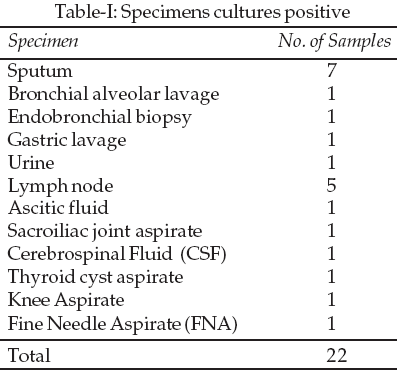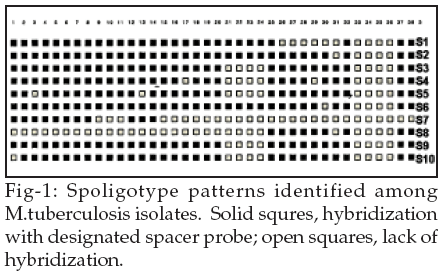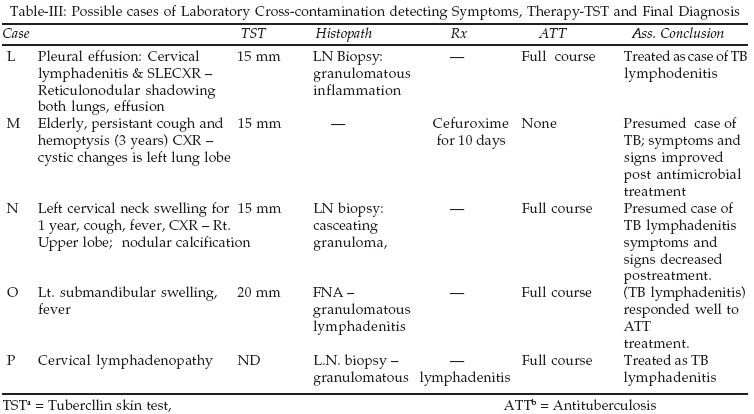|
 |
|
Published
by : PROFESSIONAL MEDICAL PUBLICATIONS |
|
ISSN 1681-715X |
|
|
|
- |
|
ORIGINAL
ARTICLE |
|
- |
|
Volume 24 |
October - December 2008
(Part-II) |
Number
6 |
|
|
|
Investigation of Cross-Contamination in a Mycobacterium
tuberculosis Laboratory Using Epidemiological
data and Spoligotyping
Fawzia Al-Otaibi1, Malak M El-Hazmi2
ABSTRACT
Objective: To investigate possible pseudo-outbreak
of Mycobacterium tuberculosis (MTB) during a two week period July 2-15th 2005,
as suggested by an increase in incidence of newly diagnosed patients with
tuberculosis. Many of them had negative Ė smears for AFB and only one
positive-MTB culture.
Methodology: Retrorespective surveys of all medical
and laboratory data using standard epidemiological tools and DNA
fingerprinting in King Khalid University Hospital, Riyadh, Saudi Arabia.
Results: A total of 22 samples representing 20
individual patients were examined. Epidemiological and laboratory analysis of
these samples revealed that 14 were identified as presumed false-positive
reports due to laboratory cross-contamination. In a further 5 cases, patients
were diagnosed clinically as having tuberculosis and were defined as cases of
possible cross-contamination. The source was a patient with both clinical and
radiographic evidence of TB and was the only one who was smear and culture
positive for TB. Molecular analysis and epidemiological studies revealed that
specimen patching and multi-use vials of buffer solution were the source of
cross-contamination.
Conclusions: This investigation strongly supports
the idea that M.tuberculosis grown from smear-negative specimens from
patients without clinical evidence of tuberculosis should be analyzed by rapid
and reliable strain differentiation techniques, such as spoligotyping, to help
rule-out laboratory contamination.
KEY WORDS: Cross contamination, Mycobacterium
tuberculosis, Spoligotyping.
Pak J Med Sci October - December 2008
(Part-II) Vol. 24 No. 6 827-832
How to cite this article:
Al-Otaibi A, El-Hazmi M. Investigation of Cross-Contamination in a
Mycobacterium tuberculosis Laboratory Using Epidemiological data and
Spoligotyping. Pak J Med Sci 2008;24(6):827-32.
1. Dr. Fawzia Al-Otaibi,
2. Dr. Malak M El-Hazmi
1-2: Department of Pathology (Microbiology)
King Khalid University Hospital, Saudi Arabia.
Correspondence
Dr. Fawzia E. Al Otaibi,
Assistant Professor, Bacteriology Unit,
Department of Pathology / Microbiology (32),
College of Medicine & King Saud University,
King Khalid University Hospital,
P.O. Box 2925, Riyadh 11461, Saudi Arabia.
E-mail: ofawzia@ksu.edu.sa
* Received for Publication: March 6, 2008
* Revision Received: March 12, 2008
* Revision Accepted: August 27, 2008
INTRODUCTION
The global increase in tuberculosis has resulted in a
substantial rise in the number of specimens cultured in diagnostic
mycobacteriology laboratories.
1
This increase and the use of molecular tools to subtype or fingerprint
Mycobacterium tuberculosis have resulted in increased recognition of
specimen cross-contamination events linked either to laboratory procedures or,
in rare cases, to contaminated bronchoscopes.2,3
False-positive cultures were identified in 13(93%) of 14 large studies that
evaluated more than 100 patients, with a median false-positive rate of 2.1%.4
However, a much higher rate (33%) has been reported from a hospital laboratory
that used a sensitive broth culture technique Mycobacterial Growth Indicator
Tube (MGIT) system, (Becton-Dickinson).5
Here we report the use of spoligotyping and epidemiological
information to confirm our suspicion that cross-contamination had occurred in
our mycobacteriology during a two week period in the year 2005 and the use of
simple procedures and changes in laboratory practices to control and prevent
similar future instances. To the best of our knowledge, no such events have
been reported from our Middle East region.
METHODOLOGY
Patient Specimens: King Khalid University Hospital, is
a 800 bed tertiary care teaching hospital that serves a population of <1.5
million inhabitants. Approximately an average of ten to twelve patients are
diagnosed monthly with culture positive MTB. After initial screening, we found
a total of 47 isolates that we suspected to be from laboratory
cross-contamination. These included isolates obtained between 15 June and 29
July 2005. Further analysis of laboratory and patient records revealed that
one cluster of cases representing 22 specimens from 20 different patients
(Table-I) were identified as suspected cases of cross-contamination. The other
clusters were believed to be genuine cases based on the criterion of smear
positivity, multiple cultures from the same patient, or clinical findings.
Epidemiological Data Collection: A retrospective
epidemiological investigation was undertaken. First, we reviewed patient
medical records and communicated with patients physicians. Data were recorded
regarding clinical history, symptoms, reason for admission, clinical course,
date of specimen collection, ward location, potential shared procedure,
radiological findings, human immunodeficiency virus (HIV) status and whether
anti-TB treatment was started and continued once sputum culture results were
reported. Secondly, we reviewed specimen logs for simultaneous processing of
smear-negative and smear-positive cases. In addition, we conducted an
investigation of the laboratory environment, specimen processing techniques,
and technologist rotation logo. All possible sources of contamination were
investigated including stains, reagents and equipments used during the
suspected period of contamination. None of the MGIT growth supplements or
antibiotics mixtures (PANTA) were available during the period of
investigation.
Specimen Processing: On receipt by the laboratory,
specimens from sites that are normally sterile were concentrated-by
centrifugation (4,000 x g for 10 min) and were inoculated onto a slant of
Lowenstein-Jensen medium (LJ) (Baltimore Biological Laboratory) and into a
MGIT- (BBL Becton Dickinson Microbiology systems, Sparks, MD). Specimens from
non-sterile sites were digested with N-acetyl-L-Cystine and decontaminated
with sodium hydroxide (final concentration 2%). The contents were then mixed
by inversion for 15 min. and diluted with phosphate buffer saline. The
phosphate buffer was prepared in 1-L bottles and divided into smaller,
multi-use containers to process eight samples at a time. The mixture was
centrifuged and the sediment twice is inoculated into MGIT tubes and a
Lowenstein-Jensen slant. All specimens were examined microscopically using
auramine-stained and acid fast smears.
Molecular Epidemiological Technique: To conduct a
retrorespective investigation examining the possibility of specimens
contamination, all 47 MTB isolates obtained during the suspected period were
sent to King Faisal Specialist Hospital and Research Center (KFSH & RC) for
characterization by spoligotyping. Spoligotyping was performed with a
commercially available kit (Isogen Bioscience).
6,7
RESULTS
Laboratory Investigation: Over a two week period in
July 2005, 20 patients had positive culture for MTB from different type of
specimens. With the exception of one patient (index patient), all had negative
smear for Acid-fast bacilli (AFB) and only one positive M. tuberculosis
culture. Three specimens, a post-bronchoscopy sputum, bronchalveolar lavage &
endobronchial biopsy were obtained from the index patient. Each of these
specimens were heavily positive (+++) on an AFB smear and were processed
during 5 consecutive days by a new technologist in the same batch as one or
more smear negative and culture positive isolates. All suspected cultures were
positive only in MIGT tubes and yielded no growth on the accompanying LJ
slants. Susceptibility testing performed on MGIT system for all isolates
showed the same pattern: Sensitive to isoniazid, rifampin, ethambutol and
streptomycin. Culturing of phosphate buffer in MGIT tube was positive for MTB
after seven-day inoculation.

Ten different spoligotypes were identified among the 47 MTB
isolates. The suspected twenty isolates had the same spoligotype pattern
designated as "S3" (Figure-1). These isolates were cultured from specimens
processed at the same time with the only smear positive index case specimen
between July 2 and July 15, 2005. Isolates grown from other smear positive
specimens had different spoligotypes.

Retrospective Patient Investigation and Follow-up:
Medical records for all 20 patients with the possibly
contaminated specimens were reviewed. The possible source was a Saudi male
admitted to the medical ward with clinical features, radiological evidence and
TST results consistent with tuberculosis. For the remaining 19 patients; 14
were identified as having presumed false-positive reports due to laboratory
cross-contamination. Isolates were presumed to be cross-contaminant if the
patientís clinical conditions and epidemiological data were not consistent
with tuberculosis. The detailed assessment of these patients is summarized in
Table-II.

When positive cultures were reported, physicians were made
aware that isolation of MTB from each of the 14 patients believed to have a
false-positive culture could be the result of cross-contamination. In six of
these patients, the positive results were early dismissed as there was no
clinical evidence of tuberculosis. However, the existence of unrelated
pulmonary diseases complicated the differential diagnosis in four patients in
whom the possibility of tuberculosis could not be clinically excluded, and one
of them was started on anti-tuberculosis therapy and suffered drug toxicity
requiring alteration in his treatment regiment. Two patients with suspected
osteoarticular tuberculosis received therapy for tuberculosis. In one of these
patients, treatment was discontinued after two month when spoligotyping
results became available. However, the other patient completed one year of
anti-TB therapy. Case notes were unobtainable for two patients. In a further
five cases tuberculosis was highly suggestive. As contamination could not be
absolutely excluded, they were defined as cases of possible cross
contamination. (Table-III)

DISCUSSION
Contamination in the mycobacteriology laboratory has been
described with both conventional and automated methods.
8,9
Although specimens should be
completely separated from one another, most laboratories process AFB cultures
in batches. Preparing non-sterile specimens for mycobacterial culture involves
a multi-step process of digestion, decontamination, neutralization, and
centrifugation, in an attempt to concentrate and recover the mycobacteria.
Carry-over from one specimen to another account for most contamination
episodes in conventional processing and it appears to occur most often during
the mycolytic, or decontamination, step of processing. In addition the use of
highly sensitive culture systems and prolonged incubation periods to grow MTB
may detect relatively small inocula of MTB resulting from cross-contamination
creating opportunities for introducing mycobacteria to cause false-positive
results. Other factors contributing to cross-contamination may include new and
inexperienced personnel, an increase in the number of specimens processed,
contaminated clinical devices (bronchoscopes) and clerical errors.10,11
In addition, several large out-breaks of false-positive culture have been
attributed to defect in the exhaust system of the biological safety cabinets
used for specimen processing.12
Our epidemiological and molecular studies revealed that
cross-contamination was due to faulty laboratory technique. Review of our lab
procedure revealed that a single and large bottle of phosphate buffer was
routinely used to process multiple samples prior to being replenished. The
same bottle was likely used for all non-sterile specimens and was the only
factor shared by these cases. Culture of the buffer container grew MTB one
week after inoculation. This documented that our pseudo-outbreak has resulted
from point-source reagent contamination, as it was limited to the specimens
processed with that single contaminated bottle of phosphate buffer. However,
the cross-contamination during the addition of antibiotic mixtures (PANTA) and
other MGIT supplements cannot be excluded. None of the solutions was available
for culture at the time of investigation. This might explain the contamination
of sterile specimen, which was cultivated directly without decontamination
step. Importantly, we found that at the time of cross contamination episode,
processing of specimens was done by two technicians. One of them had no prior
experience in the mycobacteriology lab. Several studies found that 1-2
technicians appeared to be responsible for most episodes of
cross-contamination.
13,14
This suggests that training and
experience in mycobacteriology laboratory techniques are crucial in decreasing
cross-contamination.
Recognition of this cross-contamination and its probable
cause has resulted in the revision of our lab procedures. Changes in
laboratory techniques were designed to minimize the possibility of cross
contamination. Reagents such as phosphate buffer which are used in volumes are
divided daily into smaller aliquots. Extra-pulmonary specimenís especially
cerebrospinal fluids are always processed first. In addition two full-time,
thoroughly trained and experienced, Tuberculosis technicians are dedicated to
mycobacteriology laboratory. We also designated one safety cabinet for dealing
exclusively with sputum samples and all positive cultures.
In a recent paper by Caroll, et al (2002), found that the
majority of cross-contamination events were associated with processing of
culture-negative specimens in the same batch as smear-positive samples
obtained within the first 3 days of treatment.
15
In this study the authors have suggested a set of measures
that resulted in the reduction of the cross-contamination rate for processing
of sputum for the culture of MTB from 7.3 to 2.1%. One of the important
modifications in laboratory procedures was to ensure that the order of sputum
processing went from negative to positive specimens.
A false-positive culture may have profound consequences on
the clinical management of the patient. Patients with false-positive cultures
were subjected to additional physician consultations, radiographic studies and
unnecessary administration of antimicrobial therapy resulting in adverse drug
reactions. In our experience, false-positive cultures resulted in preliminary
treatment of 7 patients, and one patient had drug toxicity. Burman and Reves
(2000) suggested specific strategies to decrease inappropriate treatment with
false-positive culture.
16
Although IS6110 analysis is current standard method for the
differentiation of MTB strains, this technique requires a mature culture, is
time-consuming, and is available only in specialized laboratories. Our
findings suggested that spoligotyping can be used as an initial screening
method to rapidly identify potential episodes of laboratory cross
contamination. The result of the spoligotype analysis suggested that the 20
strains with pattern S3 were related. However, MTB isolates grouped together
on the basis of spoligotyping sometimes can be differentiated by IS6110
fingerprinting. Unfortunately RFLP is not available in our institution.
In conclusion, our report demonstrated a lack of awareness
among clinicians and laboratory personnel of the possibility of false-positive
culture. Therefore, laboratories and tuberculosis control programs should
develop procedures to identify patients having only one positive culture. Such
patients should be further evaluated for the possibility of false-positive
cultures.
Acknowledgement
We gratefully acknowledge the assistance of King Faisal
Specialist Hospital and Research Center in performing Spoligotyping
fingerprinting of our isolates. We are indebted to Prof. A.M. Kambal for
critically reviewing the manuscript and useful discussion. We are also
thankful to Mr. Syed Abdul Khader for secretarial assistance.
REFERENCES
1. Anonymous. Tuberculosis notification update. Weekly
Epidemiol Rec 1996;71:65-72.
2. Bauer J, Thomsen VO, Poulsen, Andersen AB.
False-positive results from cultures of Mycobacterium tuberculosis due to
laboratory cross-contamination confirmed by restriction fragment length
polymorphism. J Clin Microbiol 1997;35:988-91.
3. Braden CR, Templeton GL, Stead WW, Bates JH, Cave MD,
Valway SE. Retrospective detection of laboratory cross-contamination of
Mycobacterium tuberculosis cultures with use of DNA fingerprint analysis. Clin
Infect Dis 1997;24:35-40.
4. Burman WJ, Reves RR. Review of false-positive cultures
for Mycobacterium tuberculosis and recommendations for avoiding unnecessary
treatment. Clin Infect Dis 2000;31:1390-5.
5. Nivin B, Fujiwara PI, Hannifan J, Kreisworth BN. Cross
contamination with Mycobacterium tuberculosis: an epidemiological and
laboratory investigation. Infection Control Hosp Epidemiol 1998;19:500-3.
6. Kamerbeck J, Schouls L, Kolk A, Wan Agterveld M, Van
Soolingen D, Kuijper S, et al. Simultaneous detection and strain
differentiation of Mycobacterium tuberculosis for diagnosis and epidemiology.
J Clin Microbiol 1997;35:907-14.
7. Groenen PM, Bunsctroten AE, Van Soolinges D, Van Hafner
D. Nature of DNA Polymorphism in the direct repeat cluster of Mycobacterium
tuberculosis. Application for strain differentiation by a novel typing method.
Mol Microbol 1993;10:1057-65.
8. Dunlap NE, Harris RH, Benjamin WHJ, Harden JW, Hafner D.
Laboratory contamination of Mycobacterium tuberculosis cultures. Am J Respir
Crit Care Med 1995;152:1702-4.
9. Nitta A, Davidson PT, de Koning ML, Kilman J. Mis
diagnosis of mulkti-drug resistant tuberculosis possibly due to laboratory
errors. JAMA 1996;276:1980-3.
10. Wurtz R, Demarais P, Trainor W. Specimen contamination
in mycobacteriology laboratory detected by psudo-outbreak of multi-drug
reistant tuberculosis analysis by routine epidemiology and confirmation by
molecular techniques. J Clin Microbiol 1996;34:1017-9.
11. Agerton T, Valway S, Gore B. Transmission of a highly
drug-resistant strain (strain W1) of Mycobacterium tuberculosis: Community
outbreak and nosocomial transmission via a contaminated bronchoscope. JAMA
1997;278:1073-7.
12. Maurer SS, Kreiswirth BN, Burns JM, Lavie S, Lim M,
Urban C, et al. Mycobacterium tuberculosis specimen contamination revisited:
The role of laboratory environmental control in a pseudo-outbreak. Infect
Control Hosp Epidemiol 1998;19:101-5.
13. Burman WJ, Stone BL, Reves RR. The incidence of
false-positive cultures of Mycobacterium tuberculosis. Am J Respir Crit Care
Med 1997;155:321-6.
14. Cronin W, Rodrignez E, Valway S. Pseudo-outbreak of
tubeculosis in an acute-care general hospital: epidemiology and clinical
implications. Infect control Hosp Epidemiol 1998;19:345-7.
15. Carroll NM, Richardson M, Engelkc E, de Kock M, Lombard
C, Van Helden PD. Reduction in the rate of false-positive cultures of
Mycobacterium tuberculosis in a laboratory with a high culture positivity
rate. Clin Chem Lab Med 2002;40:888-92.
16. Burman WJ, Reves RR. Review of false-positive cultures for
Mycobacterium tuberculosis and recommendations for avoiding unnecessary
treatment. Clin Infect Dis 2000;31:1390-5.
HOME
| SEARCH
| CURRENT
ISSUE | PAST
ISSUES
Professional
Medical Publications
Room No. 522, 5th Floor, Panorama Centre
Building No. 2, P.O. Box 8766, Saddar, Karachi - Pakistan.
Phones : 5688791, 5689285 Fax : 5689860
pjms@pjms.com.pk




